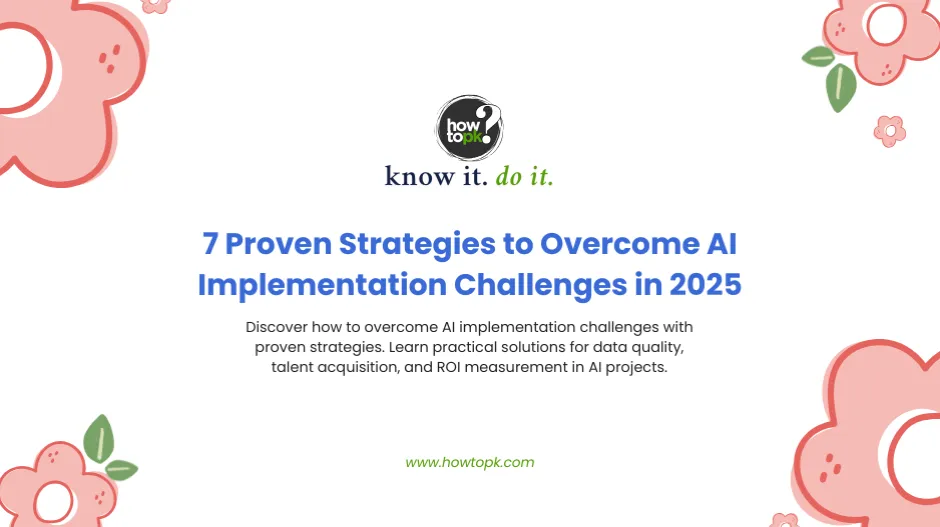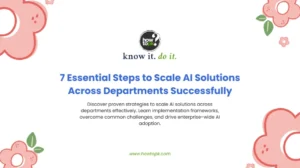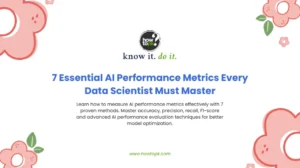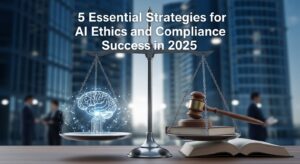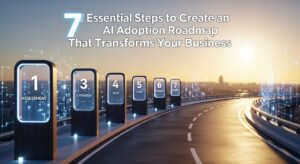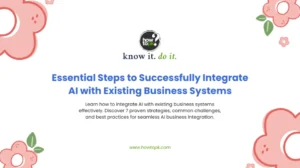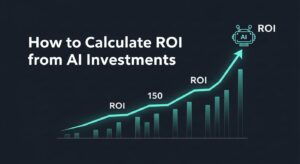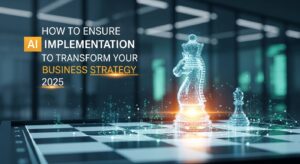Are you struggling to turn your AI vision into reality? You’re not alone. AI implementation challenges plague 85% of organizations attempting to deploy artificial intelligence solutions, according to recent industry research. The gap between AI potential and practical execution continues to widen, leaving many businesses frustrated with failed projects and underwhelmed results.
Understanding why AI initiatives fail, and more importantly, how to overcome these obstacles, can mean the difference between transformative success and costly setbacks. This comprehensive guide explores the most common AI implementation challenges and provides actionable strategies to navigate them successfully.
What Are the Core AI Implementation Challenges?
Before diving into solutions, let’s examine what specifically makes AI implementation so challenging. Think about your own organization’s experience with technology adoption. What factors typically determine success or failure?
The complexity of AI implementation extends far beyond simply purchasing software or hiring data scientists. It involves fundamental changes to business processes, organizational culture, and decision-making frameworks. Unlike traditional software deployments, AI systems require continuous learning, adaptation, and refinement.
The Hidden Complexity of AI Projects
Most organizations underestimate the interconnected nature of AI implementation challenges. Consider this: when you implement a traditional CRM system, you’re essentially digitizing existing processes. With AI, you’re often creating entirely new processes while simultaneously teaching machines to make decisions that previously required human judgment.
This fundamental shift creates cascading challenges that ripple through every aspect of your organization, from data management to employee training to customer expectations.
Challenge #1: Data Quality and Accessibility Issues
Poor data quality remains the most significant barrier to successful AI implementation. Research indicates that organizations spend up to 80% of their AI project time on data preparation and cleaning.
Understanding Data Quality Problems
What makes data “AI-ready”? Consider these critical questions:
- Is your data complete, accurate, and consistent across sources?
- Can you trace the lineage and transformations of your data?
- Do you have sufficient volume and diversity for training robust models?
Many organizations discover that their existing data infrastructure cannot support AI requirements. Legacy systems often store data in isolated silos, creating fragmented datasets that resist integration.
Practical Solutions for Data Challenges
- Implement Data Governance Early Establish clear data ownership, quality standards, and access protocols before beginning AI development. Create cross-functional data stewardship teams that include both technical and business stakeholders.
- Invest in Data Infrastructure Modern AI projects require robust data pipelines that can handle real-time ingestion, processing, and quality monitoring. Consider cloud-native solutions that provide scalable data management capabilities.
- Start Small with High-Quality Datasets Rather than attempting to clean all organizational data at once, identify specific, high-quality datasets that can support focused AI use cases. Build momentum with early wins before tackling larger data challenges.
Data Quality Metric | Target Standard | Monitoring Frequency |
Completeness | >95% | Daily |
Accuracy | >98% | Weekly |
Consistency | >99% | Continuous |
Timeliness | <24 hours lag | Real-time |
Challenge #2: Talent Acquisition and Skills Gaps
The global shortage of AI talent creates intense competition for qualified professionals. Organizations often struggle to build teams with the diverse skills required for successful AI implementation.
Beyond Technical Skills: The Full Talent Spectrum
What skills does your organization actually need for AI success? The answer extends far beyond data scientists and machine learning engineers:
Technical Roles:
- Data engineers for infrastructure development
- ML engineers for model deployment and monitoring
- AI architects for system design
- DevOps specialists for AI/ML pipelines
Business-Critical Roles:
- AI product managers who understand both technology and market needs
- Change management specialists for organizational adoption
- Ethics and governance experts for responsible AI development
Strategic Approaches to Talent Challenges
- Build Internal Capabilities Develop comprehensive training programs that upskill existing employees rather than relying solely on external hires. Focus on creating “AI-literate” teams across departments, not just technical experts.
- Partner Strategically Consider hybrid approaches that combine internal teams with external specialists. Partnerships with AI consultancies or technology vendors can provide immediate expertise while your internal capabilities mature.
- Create Learning Organizations Establish continuous learning programs that keep your teams current with rapidly evolving AI technologies. Encourage experimentation and provide safe environments for skill development.
Challenge #3: Organizational Resistance and Change Management
Cultural resistance often poses greater obstacles than technical challenges in AI implementation. Many employees fear job displacement, while others resist changing established workflows.
Understanding the Human Side of AI Implementation
Why do people resist AI adoption? Consider these common concerns:
- Fear of job displacement or skill obsolescence
- Lack of understanding about AI capabilities and limitations
- Skepticism about AI decision-making accuracy
- Comfort with existing processes and tools
Building AI-Ready Organizational Culture
- Communicate Transparently Address fears directly through honest conversations about AI’s role in your organization. Explain how AI will augment rather than replace human capabilities in most cases.
- Involve Employees in AI Development Create cross-functional AI committees that include representatives from affected departments. Give employees ownership in identifying use cases and defining success metrics.
- Demonstrate Quick Wins Start with AI applications that clearly benefit employees, such as automating repetitive tasks or providing better decision-support tools. Success breeds enthusiasm for broader adoption.
Challenge #4: Integration with Existing Systems
Legacy system integration represents one of the most technically complex AI implementation challenges. Many organizations operate decades-old systems that weren’t designed for AI integration.
Assessment Framework for System Integration
Before attempting integration, evaluate your current technology stack:
Compatibility Analysis:
- API availability and documentation quality
- Data format standardization across systems
- Real-time processing capabilities
- Security and compliance requirements
Infrastructure Readiness:
- Computing resources for AI workloads
- Network bandwidth for data transfer
- Storage capacity for training data and models
- Backup and disaster recovery capabilities
Integration Strategies That Work
- API-First Approach Develop robust APIs that allow AI systems to communicate with existing applications without requiring major architectural changes. This approach minimizes disruption while enabling gradual AI integration.
- Hybrid Cloud Solutions Leverage cloud-based AI services that can connect to on-premises systems through secure connections. This approach provides access to cutting-edge AI capabilities without requiring complete infrastructure overhaul.
- Phased Integration Planning Implement AI capabilities incrementally, starting with standalone applications before moving to fully integrated solutions. This approach reduces risk while building organizational confidence.
Challenge #5: Measuring ROI and Defining Success Metrics
Many organizations struggle to quantify AI’s business impact, making it difficult to justify continued investment or scale successful initiatives.
Beyond Traditional ROI: AI-Specific Metrics
How should you measure AI success? Traditional ROI calculations often miss AI’s long-term value creation. Consider these expanded metrics:
Operational Metrics:
- Process efficiency improvements
- Error reduction rates
- Decision speed acceleration
- Customer satisfaction scores
Strategic Metrics:
- New revenue opportunities created
- Market share expansion
- Innovation cycle acceleration
- Competitive advantage development
Establishing Measurement Frameworks
- Baseline Establishment Document current performance levels before AI implementation to enable accurate impact measurement. This includes both quantitative metrics and qualitative assessments.
- Real-Time Monitoring Implement dashboards that track AI performance continuously rather than relying on periodic reviews. This enables rapid identification of issues and optimization opportunities.
- Long-Term Value Tracking Develop mechanisms to capture AI’s compound benefits over time, including indirect effects like improved employee satisfaction or enhanced customer relationships.
Overcoming AI Implementation Challenges: A Strategic Framework
Successful AI implementation requires systematic approaches that address technical, organizational, and strategic challenges simultaneously.
Phase 1: Foundation Building (Months 1-6)
Data Infrastructure Development
- Assess current data quality and accessibility
- Implement data governance frameworks
- Establish data pipeline architectures
- Create quality monitoring systems
Talent and Skills Development
- Conduct AI readiness assessments
- Develop training curricula for different roles
- Begin recruiting key technical positions
- Establish partnerships with external experts
Phase 2: Pilot Implementation (Months 4-12)
Proof of Concept Projects
- Select high-value, low-risk use cases
- Develop minimum viable AI solutions
- Test integration approaches
- Gather user feedback and iterate
Change Management Acceleration
- Launch awareness and education campaigns
- Form AI adoption committees
- Address resistance through transparent communication
- Celebrate early wins to build momentum
Phase 3: Scaling and Optimization (Months 9-24)
Enterprise-Wide Deployment
- Expand successful pilots to broader applications
- Integrate AI capabilities across business processes
- Establish centers of excellence
- Implement governance and ethics frameworks
Continuous Improvement
- Monitor performance metrics continuously
- Refine models based on operational feedback
- Expand use cases based on proven value
- Build long-term AI strategy roadmaps
Advanced Strategies for Complex AI Implementation Challenges
As organizations mature in their AI journey, they encounter more sophisticated challenges that require advanced approaches.
Managing AI Ethics and Bias
Responsible AI implementation requires proactive approaches to ethics and bias management. Consider these strategies:
- Algorithmic Auditing Implement regular reviews of AI decision-making processes to identify potential bias or fairness issues. This includes both technical audits and business impact assessments.
- Diverse Development Teams Build AI teams that reflect the diversity of your user base and stakeholders. Different perspectives help identify blind spots that could lead to biased outcomes.
- Transparent Decision-Making Develop explainable AI capabilities that allow stakeholders to understand how AI systems reach conclusions. This builds trust and enables better oversight.
Regulatory Compliance and Risk Management
As AI regulation evolves globally, organizations must build compliance into their implementation strategies:
- Privacy by Design Incorporate data protection requirements into AI system architecture from the beginning rather than adding them as afterthoughts.
- Regulatory Monitoring Establish processes to track evolving AI regulations and assess their impact on existing and planned AI systems.
- Risk Assessment Frameworks Develop comprehensive risk assessment methodologies that evaluate AI systems across technical, ethical, legal, and business dimensions.
Future-Proofing Your AI Implementation Strategy
The AI landscape continues evolving rapidly, making adaptability crucial for long-term success.
Building Adaptive AI Capabilities
- Modular Architecture Design Create AI systems using modular components that can be updated or replaced as technologies advance. This approach reduces technical debt and enables continuous innovation.
- Continuous Learning Systems Implement AI solutions that improve automatically through operational experience. This includes both model retraining capabilities and feedback loop optimization.
- Technology Vendor Diversification Avoid over-dependence on single AI technology providers by building capabilities that can work with multiple platforms and services.
Key Takeaways for Overcoming AI Implementation Challenges
Successfully navigating AI implementation challenges requires comprehensive strategies that address technical, organizational, and strategic dimensions simultaneously.
Essential Success Factors:
- Start with high-quality data and robust infrastructure
- Invest in talent development and change management
- Implement measurement frameworks from day one
- Plan for integration challenges early in the process
- Build ethical and compliance considerations into system design
Critical Mistakes to Avoid:
- Underestimating data preparation requirements
- Focusing solely on technical capabilities while ignoring organizational readiness
- Attempting too many AI initiatives simultaneously
- Neglecting user training and adoption support
- Failing to establish clear success metrics and governance frameworks
The organizations that successfully overcome AI implementation challenges share common characteristics: they approach AI strategically rather than tactically, invest in foundational capabilities before pursuing advanced applications, and maintain focus on business value throughout the implementation process.
What challenges is your organization facing in AI implementation? The key is to start with a clear understanding of your current capabilities, define realistic goals, and build systematic approaches that address both technical and organizational requirements.
Remember that AI implementation is a journey, not a destination. The most successful organizations treat challenges as learning opportunities that strengthen their overall AI capabilities and competitive advantage.
Resources
- MIT Technology Review’s AI Implementation Guide – Comprehensive analysis of enterprise AI adoption trends
- Harvard Business Review’s AI Strategy Articles – Strategic perspectives on AI business transformation
- McKinsey Global Institute AI Research – Data-driven insights on AI economic impact and implementation best practices
- Gartner’s AI Implementation Framework – Industry-standard methodologies for AI project management
- IEEE Standards for Artificial Intelligence – Technical standards and ethical guidelines for AI development

